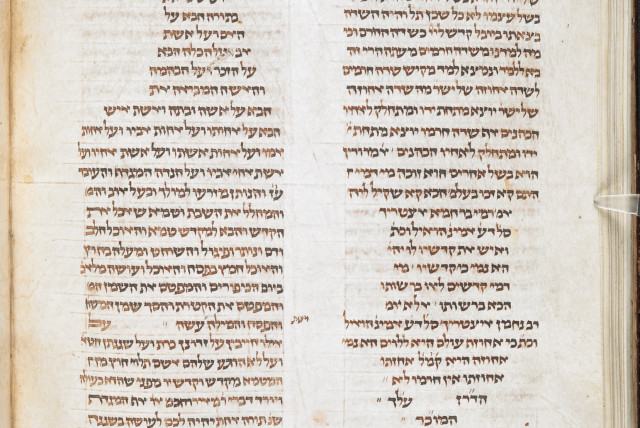A religion scholar and a zoologist find a new way to map early Jewish-Christian relations

The Talmud study, said Yovel, “is a good example of how interdisciplinarity and the use of tools from one scientific field can enrich another.”
What did rabbis of late antiquity know about Christianity?
To find out, an Israeli religion scholar turned to an Israeli zoologist who studies bats.
Their strange-bedfellows paper on the topic uses network analysis — a mathematical field used to visualize data — to map the connections of the rabbis of the Talmud with Christians who were writing and teaching at the same time, including new insights into how the literature of Christian monks made its way into Jewish thought.
Michal Bar-Asher Siegal, a scholar of rabbinic Judaism at Ben-Gurion University of the Negev, and Yossi Yovel, a zoologist from Tel Aviv University, say their approach, once it becomes widely used, could revolutionize the field of Jewish-Christian studies.
Their visualizations — picture color-coded dots representing rabbis and church elders connected by a spider web of relationships — are “a snapshot of a multi-faceted reality spread over many decades and thousands of kilometers in which Jews and Christians interact in various ways with one another,” they wrote in the May 2023 issue of Human and Social Science Communications.
The Babylonian Talmud, a vast anthology of rabbinic law and lore, was produced in present-day Iraq between the 3rd and 7th centuries CE. At the same time, Christianity was evolving from a heretical Jewish sect to a religion with growing influence across the waning Roman Empire. Like most scholars of rabbinic Judaism, Bar-Asher Siegal rejects a dated theory that Jews and Christians “parted ways” in the early centuries of the Common Era and had limited contact. But she also wanted proof beyond the painstaking scholarly method of comparing passages in Jewish and Christian texts.
For that, she approached Yovel, who works at the Bat Lab (full name: The Bat Lab for Neuro-Ecology at the Sagol School of Neuroscience). There, he uses network analysis to understand the social structures of a colony of Egyptian fruit bats. The lab’s live Bat Cam broadcasts 24/7.
For the Talmud study, he and Bar-Asher Siegal gathered rabbinic texts that seemed to have some knowledge of Christian sources and mapped the relationships among them. The results show, for example, how one rabbinic source might be familiar with many other Christian traditions, or how many rabbinic traditions showed familiarity with one Christian source.
In one example, they demonstrate the extent to which the “Sayings of the Desert Fathers” — a 5th-century collection of Christian monastic literary traditions — feature in multiple rabbinic passages.
“The application of network analysis makes it possible to identify the most influential texts — that is, the key ‘nodes’ — testifying to the importance of certain traditions for both religious communities,” Bar-Asher Siegal said in a statement from BGU. “What did the Jews know? The New Testament or later sources? And which parts of the New Testament? This leads to interesting scholarly questions: why these texts and not others? How did they know and how did they react to this knowledge?”
Proof of concept that can be used to enrich interdisciplinary studies
The authors acknowledge that their paper is only a “proof of concept” and that traditional methods have long revealed the different types of literary interactions between the rabbis and Christians, from fierce anti-Christian polemics to shared theological concepts to the occasional parody.
But they assert that network analysis, combined with extensive human input, can produce more data in less time and provide a more complete picture of the complex interplay between the two religions.
Other humanities scholars have used network analysis to study the relationships between characters in modernist novels, the family ties of prominent Britons and the relative complexity of Shakespeare’s tragedies.
The Talmud study, said Yovel, “is a good example of how interdisciplinarity and the use of tools from one scientific field can enrich another.”
Jerusalem Post Store
`; document.getElementById("linkPremium").innerHTML = cont; var divWithLink = document.getElementById("premium-link"); if (divWithLink !== null && divWithLink !== 'undefined') { divWithLink.style.border = "solid 1px #cb0f3e"; divWithLink.style.textAlign = "center"; divWithLink.style.marginBottom = "15px"; divWithLink.style.marginTop = "15px"; divWithLink.style.width = "100%"; divWithLink.style.backgroundColor = "#122952"; divWithLink.style.color = "#ffffff"; divWithLink.style.lineHeight = "1.5"; } } (function (v, i) { });

